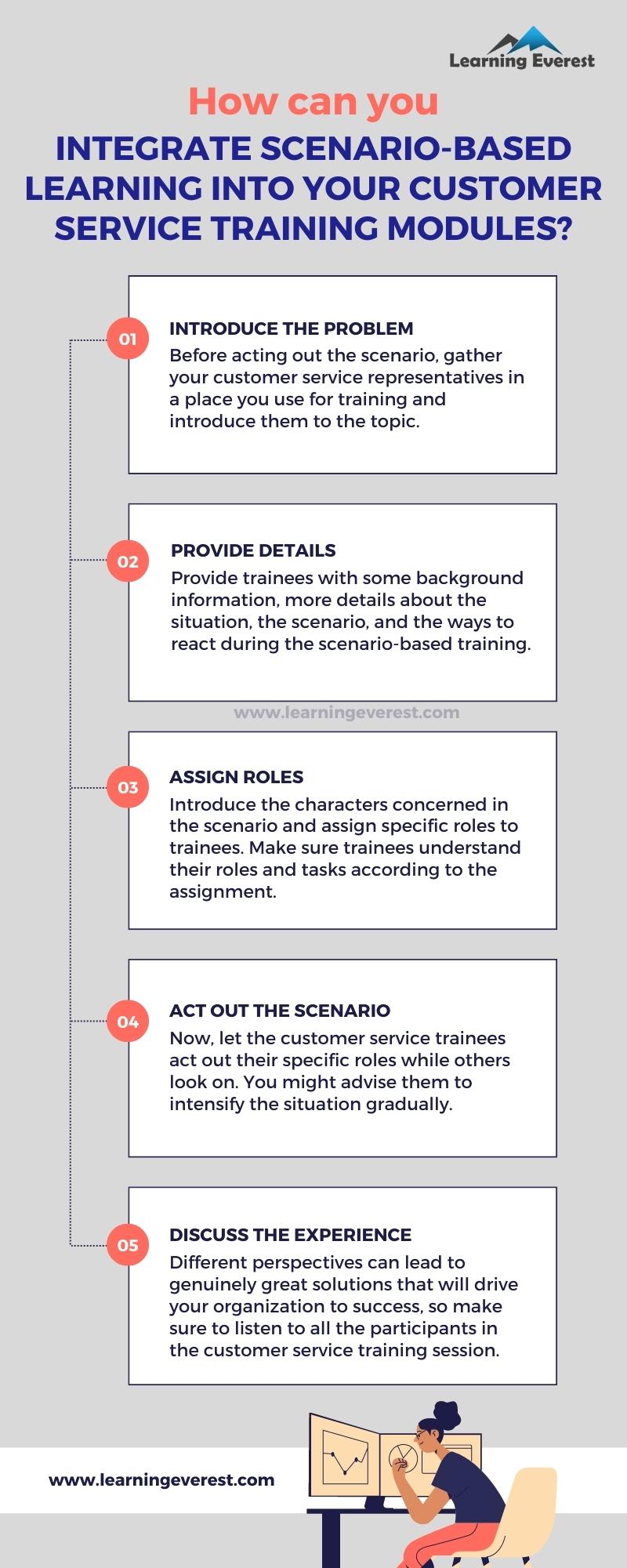If you are thinking about adding scenario-based learning to your customer service training sessions but need help with how to do this, this blog is for you. In this blog, we will take over a simple model to guide your planning of a scenario for your training course.
But what is this scenario-based training? And how can you use this for customer service training programs? Let us discuss this first!
Table of Contents
What is a scenario?
A scenario is a story with characters and real-life conflicts and situations. A scenario-based learning program offers the learners a scenario or a situation and then asks how to move forward in that given scenario to generate the learner’s response. This type of learning was developed upon the principles of the situated learning theory of Lathe and Vendor in 1991. A scenario works just like those stories you read. Instead of teaching through instructions, a scenario helps learners visualize situations involving characters playing specific roles.
Here the learner gets to make certain decisions based on the situation, leading to positive or negative consequences. A scenario-based learning environment eliminates the lack of one-on-one engagement with instructors by providing an interactive environment for experiential learning. This type of learning aims to identify a solution or response to a real-life issue. Through scenario-based learning, it is possible to provide compliance training, soft skills training, customer service training, professional skills training, leadership training, etc.
Now that you know what a scenario is check out this 5-step guide to develop a scenario where customer interactions can be practiced in safe environments by customer relation specialists to maximize their problem-solving and objection-handling skills.
Steps for creating a compelling scenario
Here is a 5-step guide You can use to integrate scenario-based learning into your customer service training modules
Step 1: Introduce the problem
Before acting out the scenario, gather your customer service representatives in a place you use for training and introduce them to the topic. Your scenario can be about an everyday situation or an unusual case, depending on the goals/objectives you set. The scenarios must force the learners to employ critical, analytical, and evaluative powers. They must encourage the learners to think creatively and put themselves in the middle of the scenario before reacting. Provide the participants with proper instructions on the training procedure.
You can explain why you decided to address the issue, the aim of the scenario, and what results you want to accomplish by the end of the training session, and let trainees discuss the topic to warm them up.
Step 2: Provide details
Once you complete the introduction to the training session, provide trainees with some background information, more details about the situation, the scenario, and the ways to react during the scenario-based training. Ensure to provide enough details for the imaginary circumstances to make it feel like a real situation.
Step 3: Assign roles
Introduce the characters concerned in the scenario and assign specific roles to trainees. For example, if you want to act out an impatient customer scenario, you will have two parts on different sides of an argument: a customer and a customer service model. Make sure trainees understand their roles and tasks according to the assignment.
Step 4: Act out the scenario
Now, let the customer service trainees act out their specific roles while others look on. You might advise them to intensify the situation gradually. While this depends on a particular case, such a method lets trainees practice several social skills and situations, which makes the session more interactive and customer service representatives more productive and engaged in real-life situations.
But most importantly, there should be an overall conclusion to every scenario. Depending on learners’ responses, there can be multiple endings to a scenario, but they, too, must be well-planned, and each path must match the course’s learning objectives. An effective way to plan endings can be starting with the outcome and returning to the beginning.
Step 5: Discuss the experience
Regardless of the outcome of the scenario, it is important to discuss it with all the participants. If a person fails to find the correct approach, invite customer service trainees to analyze the reasons, such as lack of persuasion or too aggressive communication, and suggest a different approach to handle the situation. And if an employee found the right solution for the situation, discuss what made it effective and whether there could be alternative solutions.
Different perspectives can lead to genuinely great solutions that will drive your organization to success, so make sure to listen to all the participants in the customer service training session. This type of training promotes collaboration and teamwork.
Furthermore, as scenario-based learning is a very social and dynamic process, it takes time to attain its full potential. As a result, developing a well-suited scenario can take a little longer than usual. If you want to know about more ways to create engaging scenario-based learning, check out our blog on a few scenario-based learning examples!
Infographic

How can you integrate scenario-based learning into your customer service training modules?





